The video experts blog
Comparison of the 12 Best Enterprise Video Platforms and Essential Features [Updated for 2024]
Online video content is a powerful tool for businesses for training, internal communication, product releases and demos, advertising, sales pitches, and much more.
Is your business ready to start creating online content? If so, you need to find an enterprise video platform to host your content.
But what features do you need for an enterprise video platform? We are here to help you learn about video platform features that will benefit your business so you know what features to look for when choosing the best posting platform for your business.
In this article, we’ll review the essential features of an enterprise video platform as well as compare the top 12 video CMS software systems on the market for enterprises and consumers. Here are the specifics of what we’ll be covering:
When it comes to live streaming video content, it pays to do your homework and weigh the pros and cons of each enterprise and consumer-grade video solution, and that’s why we’re here to help.
While you may be wondering “what is the best enterprise video platform” now, by the end of the article, you’ll have your answer and a lot of helpful information about enterprise video sharing.
We will help you choose the best enterprise video streaming solution for your business needs.
Let’s get started!
Table of Contents
- Introduction
- Enterprise Platforms vs Consumer-Grade OVPs
- Comparison of the 12 Best Enterprise Video Platforms in 2023
- Brightcove
- IBM Cloud Video Vidyard
- Vimeo Livestream
- Vidyard
- Hippo Videohippo video hosting platform
- Kalturakaltura Business Video Platform
- Cincopa
- JWPlayer
- StreamShark
- Dacast
- Muvi
- Twenty Three
- FAQ
- Final Thoughts
Enterprise Platforms vs. Consumer-Grade OVPs


Have you ever used or watched content on YouTube Live, Instagram Live, or Facebook Live? If so, then you have used one of the three major consumer-grade online video platforms (OVPs). These are the biggest platforms for consumers; there are many smaller consumer-grade OVPs as well.
What makes these platforms consumer-grade is they are free for people to use, and they are designed for the masses. They are social media platforms with content-sharing capabilities.
The biggest advantage of consumer-grade OVPs is that millions of people use them, and they can be a good way to connect with your audience on platforms they already use. Additionally, consumer-grade OVPs have a low barrier to entry, meaning you can get started with video creation and hosting on them with ease. It’s also a great way to give your video content the reach it deserves online. However, for businesses, there are some major drawbacks to using consumer-grade OVPs as the sole source for your video hosting.
- Content restrictions: All consumer-grade OVPs have content restrictions and rules you have to follow. If they find that your content violates these rules, they can take it down. You often have little recourse when it comes to appealing content take-downs on free platforms.
- Lack of monetization: Many free consumer-grade platforms have limited or no direct monetization methods. Others, like YouTube, run advertisements on content and allow you to apply to their monetization program, but only if you meet specific requirements. So, you can primarily use these consumer-grade platforms for increasing online delivery of your content, but nothing more.
- Outside branding: When you share content on a free consumer-grade platform, your branding isn’t going to be central or even included outside of what is contained in the content of your video. Consumer-grade platforms may impose their advertisements and branding elements on your videos. This will hinder you from creating a consistent brand image.
- No simulcasting: When working directly with consumer-grade OVPs, you can’t multi stream or simulcast to other social media platforms and sites at the same time. Some allow you to embed links in other places, but you don’t have access to simulcasting software.
- Security: When using consumer-grade platforms, you may not enjoy the same level of security as you would with enterprise solutions. Hence, if your business deals with large volumes of sensitive content, consumer-grade platforms may not be the best solution.
- Lack of customization: With a consumer-grade OVP, you cannot customize the video player and don’t have API access. You get what you get and can’t customize the video player or how you use it. In most cases, there’s no way to add your branding to the player on consumer-grade OVPs. You can deliver your videos online and brand them, but not the player itself.
Those are a few of the reasons why working with a consumer-grade OVP isn’t the best for businesses that want to use video for a specific purpose, such as internal training, marketing, or sales pitches.
However, consumer-grade OVPs work out very well for creators and influencers. Even businesses can use them in collaboration with enterprise-grade video platforms to increase the online reach of their content and enhance the delivery.
The distinct advantage of publishing some of your content on consumer-grade OVPs is that you can access their vast audience base and use it to attract users to your own video platform.
When you work with business-to-consumer video hosting platforms, you lose control and rights to your material, which is why you should use a private enterprise video platform.
A few other drawbacks of working with a business-to-consumer video hosting platform include:
- Limited security functionality, meaning piracy can be a problem
- Indiscriminate advertising with little to no control over ads associated with your content
- Lack of technical support
- Overly sensitive copyright protection mechanisms that may find false positives and take video offline
- Suggestions that may drive viewers to unrelated content, competitors, or critiques
- Public comments and likes can serve as a place for naysayers and disgruntled individuals to make unpleasant comments.
As an enterprise, you may wonder: what’s the solution to these problems? Simply put – why not opt to use a powerful enterprise video platform instead? An enterprise video platform provides all the enterprise-grade features you need for successful operations and none of the above-mentioned concerns.
An enterprise video platform goes by many names, including live streaming and video hosting platforms, video content management (CMS) systems, and video streaming services. All of these names refer to the same type of platform.
An enterprise video platform is a video streaming service that is designed to fit the needs of larger clients. They are full of features that help you better manage, protect, promote, and share your content in order to meet your business goals.
To help you out, we have identified 5 key features that an enterprise video platform should offer.
- Powerful CDN for streamlined global delivery
- Secure video delivery
- Multi-level access for user management
- APIs for integration and development
- A white-label platform for branding
- Video access control
These five features are designed to support large enterprises‘ video hosting and streaming needs. Each feature helps solve a problem that an enterprise or organization is facing.
We are going to dive into deep detail on each of these five points so you fully understand what they mean and why these features matter in regards to video content delivery.
1. Powerful CDN For Streamlined Global Delivery
CDN stands for Content Delivery Network. A CDN is a distribution model that makes the delivery of multimedia internet content faster and more reliable for a global audience. Any digital asset (such as a video or stream) that reaches viewers by CDN is copied in real time.
From there, these copies reach a network of hundreds or thousands of servers in different geographic locations. When users seek to access your content, the CDN or multi-CDN solutions redirect them to the servers closest to them.
Not only do multi-CDN solutions help bring content to viewers faster, but they also provide enterprises and organizations with better streams that help bring back viewers time and time again. Powerful CDNs are a top feature to look for in an enterprise video solution.
Before you zero in on an enterprise video platform for your company, it’s essential to check if the CDNs they’re using are optimized for video delivery. The CDNs must also be distributed well geographically to ensure that the content reaches your viewers quickly. This is especially important as many video platforms aren’t capable of delivering video inside China.
Reduce latency and buffering with a live streaming CDN
In this way, the toll on expensive hardware is balanced across many different machines. In addition, a CDN minimizes latency—the time between when you start to live stream and when the stream plays on your viewer’s device. And buffering and packet loss are also kept to a minimum. Meanwhile, security increases and bottlenecks disappear.
If your servers are attacked using common hacker methods like DDoS, the content will still remain online. In other words, redundancy is automatic with a live streaming CDN.
Scale up your video with a top-tier CDN
Most importantly, access to a CDN allows you to “scale up” your video. The CDN approach lets enterprises handle anywhere from one hundred to one million concurrent viewers. These figures are especially accurate if you’re using a top-tier CDN like Akamai. Akamai has a network of more than 230,000 servers worldwide. This high “point-of-presence” means that the Akamai CDN is within a single network hop of more than 85% of all internet users.
With a professional live streaming CDN, enterprises and organizations alike can save money by offshoring the construction, maintenance, and upgrading of the network to another business. This IaaS (Infrastructure as a Service) model is highly preferable for most businesses. In particular, this model eliminates the need to roll out a live streaming server and an entirely new division to significantly invest in.
The takeaway? A high-quality enterprise video platform should use a top-tier CDN to ensure a global content delivery experience. A top-tier CDN will help get content to your viewers in a timely manner.
2. Secure Video Delivery
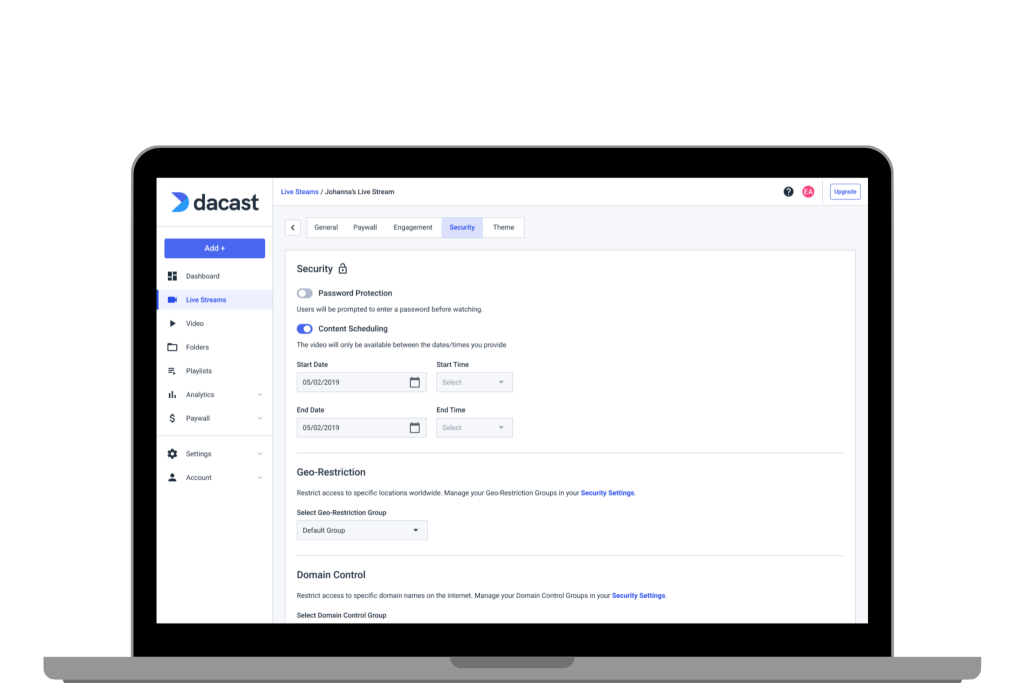

Next up is professional enterprise video platform privacy and security. As you likely know, corporate users often deal with sensitive information. This sensitive content could include:
- Medical records
- Valuable intellectual property
- Information related to lawsuits
- Financial records and bank or credit card account information
- Business plans, contract data, and confidential trade secrets
- Classified or sensitive research data
- Passwords, biometric data, or signatures
- Social security numbers and other personal data, such as addresses and contact information
- Training and information on innovative practices for competitive advantage
These are just a few of the many categories of sensitive information that businesses, as well as organizations, want to protect. Enterprise video solutions should also provide a variety of tools for securing video in their network. These tools can include the following:
Password protection
Enterprises can restrict access to video content in a variety of ways. One of the most basic methods is password-protected streaming. This feature allows only users who enter a specific password or passphrase to access a given video recording or live stream. All enterprise video platforms should offer this basic security feature.
Geographic and domain restrictions
Restrictions are tools that narrow down the pool of internet users who can access your content. The geographic restriction allows you to “whitelist” select nations. Only users who are located in these countries (as determined by their IP address) can access video content.
Domain restrictions take a similar approach but instead limit video embedding based on a domain name. For example, you could restrict your videos to only play on the Dacast.com domain name.
Let’s say that pirates or other malicious actors are able to access the raw URL for your live video stream. With domain restrictions, however, they can’t embed streaming content on other sites or access it via desktop players.
Geographic and domain restrictions are important security features that an enterprise video platform should offer.
Payment security and HTTPS encryption
Finally, if you intend to monetize your videos in any way, payment security is a critical part of your enterprise video strategy. Make sure that your OVP includes payment security features. Bank-grade SSL encryption should also be standard practice here.
General HLS encryption is another layer of security for your video-on-demand and streams. HTTP Live Streaming security ensures data integrity, protects against many forms of eavesdropping, and thwarts man-in-the-middle (MITM) attacks. These security features should be a part of any enterprise video platform worth your money.
While we mention the need for a secure online video platform, we want to showcase twelve popular enterprise video platform options in the industry. After the five features are discussed in this article, we’re going into a comparison of the different video CMS platforms available.
We’re giving you this heads up to make sure that you scroll to the bottom of the article to read through the comparison of features, pros and cons, and pricing.
The takeaway? Choose a video CMS enterprise software or the best enterprise video platform that offers multiple security and privacy features to secure video on your business’s network.
3. Multi-level Access for User Management
Video CMS platforms often have to manage access credentials for a wide range of users. Some employees may have unrestricted access, while others are only able to access certain content. On the other hand, some may need extended access without access to certain features.
These tiered access options reduce the risk of accidentally causing problems behind the scenes and for your viewers as well. Therefore, an enterprise video platform should offer some sort of feature for multi-user management.
This ensures that only those users in your enterprise who are supposed to access the content or features will be able to. The rest will need to request access to it separately.
Dacast’s streaming solutions, for example, allow your enterprise to restrict specific users while giving certain users permissions to access:
- Video-on-demand
- Package management
- Playlist management
- Analytics
- Account details
- Preferences
The takeaway? Look for an enterprise video platform that offers multi-level access features that fit your business needs. That way, you can have multiple members of your team working on your videos.
4. APIs for Integration and Development
Enterprise video platform users often require custom-built applications and integrations for streamlined operations. This is enabled by video streaming APIs or Application Programming Interfaces. Make sure to choose a well-documented API, with clear code samples and sandbox.
APIs enable some excellent capabilities, such as becoming a video platform reseller, creating custom video portals, and building apps around your streaming or on-demand video content. APIs also ease integration with databases of all sorts and allow for custom development.
APIs also enable you to seamlessly integrate your enterprise video platform with other enterprise systems. These include content management systems (CMS), learning management systems (LMS), and customer relationship management platforms (CRM).
The takeaway? When selecting an enterprise video platform, make sure that a full-featured live video API is available and functional.
5. White-label Platform for Branding
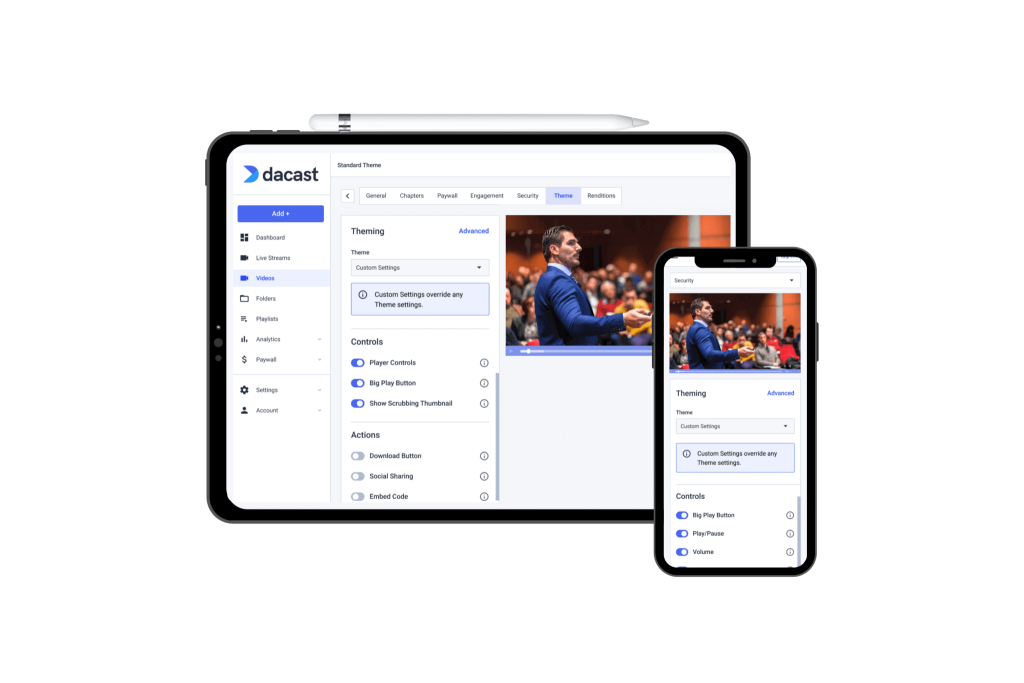

Put your brand in your video content. When you use an enterprise video platform, you have the ability to add your own brand to every video you stream.
Last but not least, a white-label service is a major key feature to look for in a video CMS platform. If you’re unfamiliar with the term, white-label refers to non-branded services. For an enterprise video platform, white-label service allows you to deliver video content completely free of outside branding.
You can then easily insert your own branding. Having your own branding available on the video allows new viewers to learn about your company or organization when the video is shared online.
This feature contrasts sharply with free platforms like YouTube or Facebook. These B2C platforms insert the logo of the respective host service on every single video—whether embedded or native.
The takeaway? White-label service is essential for corporate users who seek to maintain a highly professional, coherent appearance at all times. Any enterprise video platform you work with should offer white-label services.
This way, both your video and the player itself will have your business branding. It can help you appear more professional. At the same time, it can aid in boosting your brand awareness much more effectively than consumer-grade OVPs that are widely used by everyone.
Comparison of the 12 Best Enterprise Video Platforms in 2023
Now it’s time to compare the top 12 enterprise video streaming platforms. In this section, we’ll compare the following:
- Overview and Company History
- Basic Functionality
- Key Features
- Detailed Features
- Pros and Cons
- Pricing
Let’s dive into the comparison.
1. Brightcove
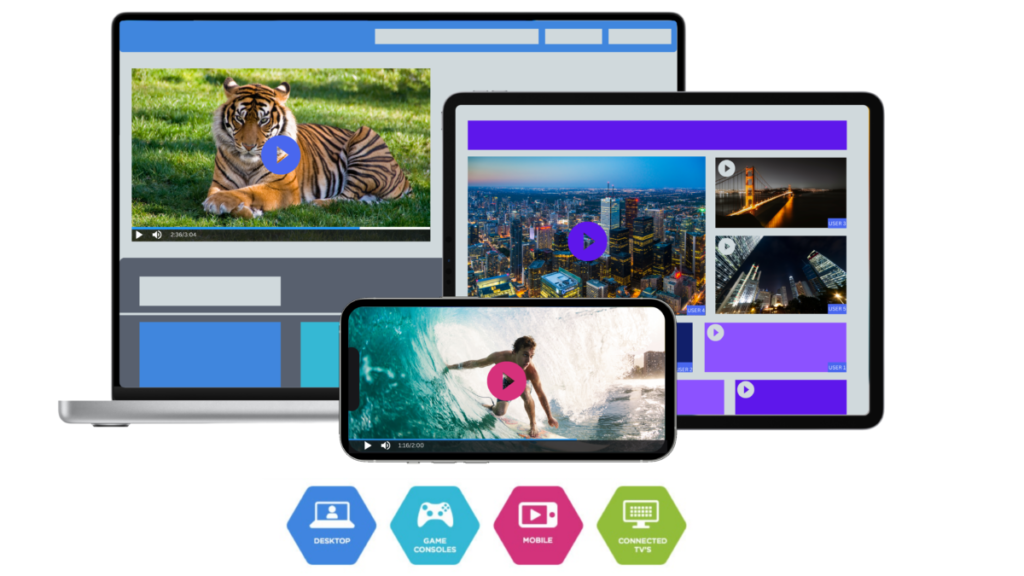
Overview and Company History:
Brightcove is a Boston-based software company that produces an online platform for enterprise video management. This enterprise video platform was founded in 2004 by Jeremy Allaire and Bob Mason. The company was named after a harbor the founder liked to kayak in. Brightcove recently acquired Ooyala and announced the end of life of the Ooyala video platform itself.
Basic Functionality:
Brightcove is an online enterprise video software that targets large businesses. Brightcove divides its product offerings into several discrete categories. These include Video Player, OTT Flow, Video Marketing Suite, and a number of others. Among other offerings, Brightcove’s streaming and hosting platform is called Video Cloud. This platform includes an all-screen player and supports monetization.
Key Features:
Brightcove’s technology claims to defeat ad-blockers and succeed in inserting video ads into content streams. While it’s not clear if this method is able to defeat the latest generation of ad-blockers, it’s still valuable for businesses following that model of content monetization. Additionally, it is an enterprise video platform with valuable and functional marketing tools.
Detailed Features:
- Multi-bitrate and adaptive streaming
- Global content delivery
- Tech support, but only at a basic level with slow ticket-based responses (unless you upgrade to a paid support plan)
- Video API access, but only on custom-priced plans
- Security features, but with high-end features only available on custom plans
- Monetization options, but only on custom-priced plans
Pros:
- Good analytics
- Secure hosting
- Includes custom video portals
- CRM integration
Cons:
- High price point
- No live streaming with packages under $499/month
- Monetization limited to custom-priced plans
- No China video hosting
Best Use Cases
- Live streaming sports
- Streaming video for sales
- Live event streaming
- Enterprise video hosting
- Marketing video hosting
Technical Specifications:
- Recommended dimensions: Determined by user
- Supported aspect ratios: Determined by user
- Maximum file size: Unlimited
- Maximum video length: Unknown (No limits are published)
- Total file storage: Depends on the plan
- Accepted video formats: MP4, .MOV, .AVI, .WMV, .FLV, .MKV, 3GPP
Pricing:
Brightcove doesn’t publish its pricing plans for Video Cloud live streaming services online. For a customized quote, you need to contact them directly to discuss your specific business needs. For more details, you can check out this third-party review of the enterprise video platform as well. Note that this might change following the absorption of the former Ooyala video platform.
Brightcove is a strong enterprise video software for large enterprises.
2. IBM Cloud Video


Overview and Company History:
First up in our enterprise video platform comparison is IBM Cloud Video (formally UStream). Founded in 2007 to connect military service members with family, IBM purchased UStream in 2016 to form IBM Cloud Video.
Basic Functionality:
IBM Live Video is a live streaming company first and foremost. However, it is also an enterprise video platform that hosts VOD (Video On Demand) files recorded from previous live streams. Basic streaming accounts are free, with advertising supporting IBM Cloud Video. Paid accounts remove advertising and grant access to advanced features. Enterprise accounts allow for full custom branding and offer analytics, multiple live channels, content syndication, and more. IBM is a secure live streaming platform that offers phone support for Pro and Enterprise users, and forum-based support for free users.
Key Features:
IBM Cloud Video provides both a customer-grade and an Enterprise streaming solution. This platform also offers a unique Enterprise Content Delivery Network. This enterprise video platform has solutions for live event coverage, video marketing, monetization, marketing, and more. Its inclusivity justifies its elevated price point. That said, its entry-level pricing plan is slightly affordable for smaller businesses and solopreneurs, making it a great enterprise-grade solution for them.
Detailed Features:
- Enterprise video streaming
- Enterprise content delivery network
- Video distribution and workflow
- OTT video management
- Monetization
- Live streaming
- API access with video embed controls
- HD transcoding
- Live monitoring console with phone and chat support
Pros:
- Reliable platform
- Suitable for larger clients
- Good customer support
- Wide range of features for broadcasters
- Hong Kong (China) video hosting
- Secure video hosting
Cons:
- Additional fees are required in order to stream above 720p resolution
- Poor closed captioning support
Best Use Cases:
- Live event streaming
- Marketing video hosting
- Enterprise video hosting
- Streaming video for sales
Technical Specifications:
- Recommended dimensions: 4K (3840×2160)
- Supported aspect ratios: Unknown (Not published)
- Maximum file size: 4 GB
- Maximum video length: Unknown (No limits are published)
- Total file storage: 1 TB – 5 TB, depending on plan
- Accepted video formats: MKV, MP4, MOV, FLV, AVI, WMV, MPEG2, H264, H263, MPEG4, VP6, VP8, THEORA, WMV, MP3, AAC-LC, NELLYMOSER, PCM, SPEEX, VORBIS, WMA
Pricing:
IBM offers a 30-day free trial period. Its pricing plans range from $129 to $1299 per month and include the following:
- Silver: $129/month
- Gold: $649/month
- Platinum: $1299/month
- Custom: Please contact IBM Cloud video for custom plan pricing.
You can check out this third-party review for more details. IBM Cloud Video is a strong enterprise video platform.
3. Vidyard


Vidyard is a great option for enterprise video hosting.
Overview and Company History:
Vidyard is an enterprise video platform that provides features for marketing and lead generation. That’s why its packages are built for marketing, sales, and corporate communications.This business video platform also has something for small businesses, solopreneurs, and even consumers.
Basic Functionality:
This is a comprehensive enterprise video platform that is geared toward turning viewers into customers.
The Vidyard platform includes tools to improve audience reach and viewer engagement so that its users can generate qualified leads.
What helps it stand out from the rest of the enterprise live streaming platforms is that its pricing isn’t all that prohibitive. In fact, it offers a free plan that can even help creators tap into the advantages of using an enterprise-grade solution for online video content delivery.
Key Features:
Vidyard is designed to assist marketing, sales and corporate communications teams in turning their viewers into customers.
The business video platform is particularly geared toward small and medium-sized businesses that don’t have the big budget needed for enterprise-grade features. They bring all those features together at a lower price point.
But that’s not to say that the platform isn’t meant for enterprises. Its Business plan is particularly meant for larger organizations.
Detailed Features:
- Marketing tools for SEO, email, personalization, and analytics
- Interactive viewing and lead capture tools
- Video organization and channels
- Enterprise-grade security for secure content delivery
- Video analytics and real-time insights
- Automatic captioning and video SEO function
Pros:
- Comprehensive professional broadcasting capabilities
- Useful analytics
- Great technical support
- A large user community for additional help
Cons:
- Mixed user reviews and consistency issues
- Complicated backend editing portal
- No China video delivery
Best Use Cases:
- Sales and marketing
- Enterprise-level live streaming
Technical Specifications:
- Recommended dimension: 360p (480 x 360) to 4k (3840 x 2160)
- Aspect ratio: 16:9, 4:3
- Max file size:5GB to 16GB (depends on the plan)
- Max video length: 1 hour (live stream)
- Total file storage: Not available
- Compatible video formats: WEBM, MP4, MKV, MOV
Pricing:
Vidyard allows you to sign up for free and offers a 14-day free trial on all its pricing plans. They come in four tiers. All plans are billed annually or monthly and are priced as follows for annual payments:
- Free – $0/month
- Pro – $19/month
- Plus – $59/month
- Business – Custom pricing
Vidyard has a strong focus on marketing and lead generation. If that is your content focus, then Vidyard could be a good enterprise video streaming solution for your business.
4. Vimeo Livestream


Vimeo’s Livestream offers enterprise-grade live broadcasting as well as video hosting services.
Overview and Company History:
Originally founded in 2007 as “Mogulus,” Livestream represented one of the largest live streaming companies in the world. In 2017, Vimeo acquired the Livestream platform. Since the acquisition, the two platforms have merged their services. Today, this enterprise video platform powers over 10 million events per year and focuses on an integrated system of hardware, software, and cloud services.
Basic Functionality:
Vimeo Livestream offers both streaming and video hosting services. This basic functionality includes analytics, a video management platform, privacy controls, and more. To access basic live streaming functionality, users must purchase a Premium plan. This enterprise video platform provides tech support via email for video hosting plans. For live support, users must purchase a Premium or Vimeo OTT custom plan.
Key Features:
What sets Vimeo Livestream apart from other enterprise video software is its offering of a range of proprietary hardware and software for live streaming. These offerings integrate smoothly with their platform, minimizing the fuss of implementing a live streaming program from the hardware on up.
Detailed Features:
- Video management service
- High-quality videos and streams
- Large storage capacity
- Privacy options
- Upload from anywhere
- Full HD 1080p live streaming
- API and SDK support
- Streaming analytics and insights
Pros:
- Unlimited events and viewers
- No ads
- Sleek and professional appearance
- Thoroughly detailed analytics
- Easy to use
- Pay-per-view option
Cons:
- Does not generate as much traffic as other sites
- No China video hosting
Best Use Cases:
- Live event streaming
- Marketing video hosting
Technical Specifications:
- Recommended dimensions: 720p (1280×720)
- Supported aspect ratios: 16:9, 4:3
- Maximum file size: 3 GB
- Maximum video length: Unknown
- Total file storage: Unknown
- Accepted video formats: MP4 (recommended)
Pricing:
Vimeo Livestream offers three main pricing plans, including:
1) Vimeo Premium:
- Premium pricing: $65/month
- Their Premium plan includes both live streaming and VOD support. This plan is the best option for professional broadcasting on this platform.
2) Vimeo Enterprise:
- Enterprise Pricing: Please contact Vimeo for custom pricing information
- The Enterprise plan includes white-label service, monetization, and video API access. It also includes branding control and added security features.
3) Vimeo OTT:
- Vimeo OTT takes on a pay-as-you-go pricing structure. However, you need to get in touch with the Vimeo team to find the pricing of Vimeo OTT.
For more details, you can check out this third-party review of the enterprise video platform. Vimeo is a strong enterprise streaming solution if your focus is on live content.
5. Hippo Video

Hippo Video is a newer video hosting platform for professional broadcasting.
Overview and Company History:
Hippo Video is a business video hosting platform that offers a variety of streaming tools for marketing, sales, education, and more. This enterprise video platform is unique in the sense that it has plans for broadcasters with a wide range of budgets. That makes it a great option for smaller businesses
Basic Functionality:
The basic functionality of Hippo Video is video hosting and streaming for sales professionals, marketing professionals, and educators. From video emails and video personalization to basic marketing tools, Hippo Video has all that you need from an enterprise-grade online video delivery platform.
Key Features:
Aside from video hosting, Hippo Video is an enterprise video platform equipped with tools for video editing and creation.
But what really sets it apart from the rest of the enterprise live streaming platforms in this post are its numerous AI-powered features. In fact, Hippo Video comes with three compelling AI-powered tools.
It is an enterprise video platform that offers an AI script writer that helps you create video scripts in a jiffy. Additionally, it takes the hard work out of the video editing process by providing its AI video editor.
And if that wasn’t enough, this enterprise video platform also has a new feature called Humanize AI that helps you personalize your videos for viewers. All you have to do is upload your voice message and the tool will personalize the audio and background at scale to deliver perfectly relevant videos to your audience.
Detailed Features:
- Business video hosting
- Editing and creation tools
- Customizable streaming experience
- Video marketing tools (CTAs, analytics, etc.)
- Screen recording support
- Tools for collaboration
- AI-powered script writer and other tools
Pros:
- Wide range of hosting tools
- Plans for every budget
- Customization options
- Diverse functionality
- AI-powered tools for personalization
Cons:
- Some complaints about the customer support
- Reports of bugginess on the platform
- The built-in editor can be glitchy
Best Use Cases:
- Business video hosting
- Educational video hosting
- Video for marketing
- Video for sales
Technical Specifications:
- Recommended dimension: 480p (852×480) to 1080p (1920×1080)
- Aspect ratio: not available
- Max file size: 3 GB
- Max video length: 5 minutes on Free plans, 2 hours on Premium plans
- Total file storage: n/a
- Compatible video formats: not available
Pricing:
Hippo Video has a simple pricing structure even though it offers a variety of solutions for different use cases. Here’s a breakdown of pricing:
- Free – $0
- Pro – $20/month
- Teams – $60/month
- Enterprise – $80/month
Users can contact Hippo Video directly for recorder API pricing. All of the prices above reflect the rate when billed annually. Please check out the Hippo pricing page for more information on quarterly and monthly pricing.
6. Kaltura
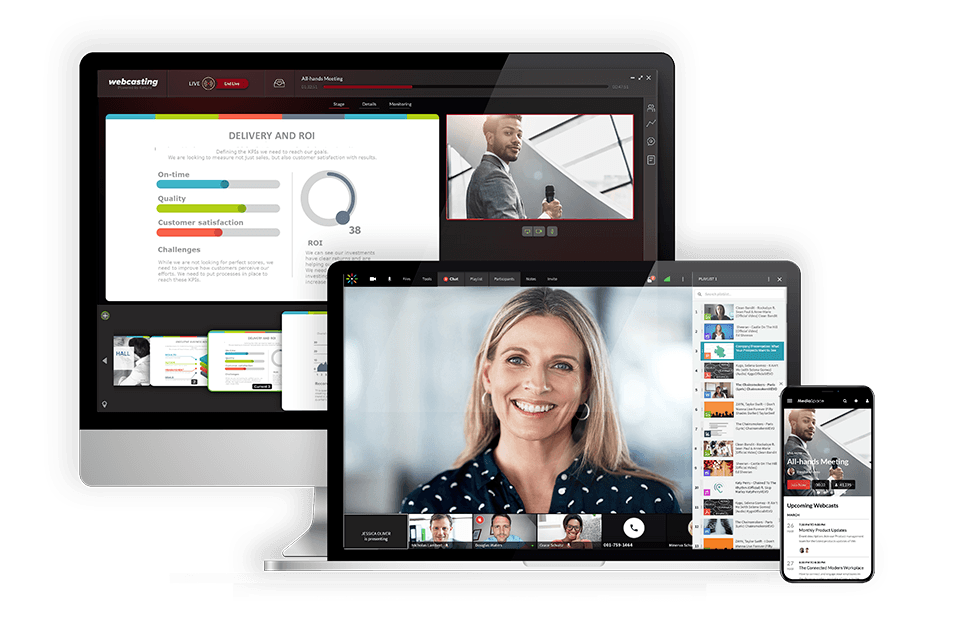
Kaltura is an enterprise video platform and cloud video streaming solution geared towards large institutions.
Overview and Company History:
Kaltura is a New York-based software agency that was founded in 2006. It is an enterprise video platform with a video management foundation in its open-source software. Therefore, Kaltura offers a unique focus in the OVP market.
Basic Functionality:
While the Kaltura software is free, it requires an infrastructure of servers for hosting and distribution. This enterprise video platform represents an alternative to the self-hosted model (e.g., Dacast). That said, Kaltura offers cloud-based video hosting and distribution services for both VOD and live streams.
Key Features:
Kaltura shines when it comes to extensibility. The open-source nature of this business video platform means that a community of users creates and shares countless add-ons and integrations. The downside of Kaltura’s extensibility, however, is that the platform can be confusing to use. With so many different features, it can be overwhelming for beginner users.
Detailed Features:
- Multi-bitrate and adaptive streaming are included
- Global content delivery via a combined CDN approach (with the option to bring your own CDN)
- Tech support via a ticket-based system, which is slower than chat or phone
- Extensive video management tools with Video API access
- Security features, including a range of authentication and encryption options
- Monetization, including all major models (subscription, advertising, PPV streaming)
Pros:
- Many available features
- Good monetization options
- Robust security for secure viewing
Cons:
- No phone or chat support
- Highly complex
- No China video hosting
Best Use Cases:
- Marketing video hosting
- Streaming video for sales
- Live event streaming
- Enterprise video hosting
- Streaming video platform for online live classes
Technical Specifications:
- Recommended dimensions: 180p (320×180) to 1080p (1920×1080)
- Supported aspect ratios: 16:9, 4:3
- Maximum file size: 2 GB
- Maximum video length: Unknown (No limits are published)
- Total file storage: 10 GB to unlimited, depending on the plan
- Accepted video formats: MOV, MP4
Pricing:
Kaltura doesn’t publish pricing information on its website. However, some users have said that plans start at about $1000 per month and go up from there. For more details, you can read about this enterprise video platform’s pay-for-what-you-use pricing model.
If you are looking for an open-source video distribution system, Kaltura is a strong choice for larger enterprises.
7. Cincopa


Cincopa is a live streaming platform that is most commonly known for multimedia hosting.
Overview and Company History:
Cincopa is a unique enterprise video platform and multimedia hosting solution that provides tools for storing and managing video, photo, and audio content.
Almost all of the other providers we’ve reviewed in this article support video hosting exclusively. Many businesses prefer a dedicated video hosting service, but Cincopa is a great enterprise video platform for businesses and organizations that need more than that.
Basic Functionality:
Cincopa provides all of the tools that enterprises need for a professional streaming experience. Some of the top features include video monetization, stream recording, OTT streaming, enterprise video management, and reliable content delivery. Cincopa also supports a variety of integrations for a customizable streaming experience.
Key Features:
Cincopa is an enterprise video platform that is capable of hosting video, audio (podcasts and music), photos, and more. It also enables enterprises to live stream their content to a massive audience. You can even do mobile and TV streaming using the platform.
Additionally, Cincopa comes with video SEO and monetization features that make it easy for you to get your video to rank in the SERPs. The monetization options make it a great enterprise video platform for course creators.
Detailed Features:
- Live streaming and videos-on-demand via CincoTube
- Multimedia storage and management
- Efficient video player
- Video monetization tools
- Wide variety of integrations
- Powerful CDN partnerships
- Secure streaming online
- JSON-LD meta data for Video SEO
- Seamless integration with third-party apps
- Supports image uploads
Pros:
- Highly professional solution
- Large collection of streaming tools
- Unique functionality
- Customizable streaming experience
- Reliable tech support
- Secure video viewing experience
- Real-time video analytics
- Video hosting for large teams
Cons:
- Video streaming is not the primary offering
- Some complaints of media storage limits
Best Use Cases:
- Enterprise video hosting
- Multimedia management for businesses
- Live streaming
Technical Specifications:
- Recommended dimensions: 144p (256 x 144) to 4k (3840 x 2160)
- Aspect ratio: 4:3, 16:9
- Max file size: 1, 2, 20GB (depending on the plan)
- Max video length: not available
- Total file storage: 5 videos, 40 videos, unlimited videos (depending on the plan)
- Compatible video formats: AVI, MOV, WMV, MP4, M4A, F4A, F4B, F4V, F4P, M2TS, MTS, VOB, MKV, RMVB, M1V, QT, DIV, DIVX, DV, 3GP, 3GPP, 3G2, MPG, MPEG, MPE, FLV
Pricing:
Cincopa offers three different pricing plans, including:
- Plus: $30/month; includes marketing tools (CTAs, email integrations, etc.)
- Corporate: $119/month; advanced broadcasting tools
- Agency/Enterprise: $420/month; advanced broadcasting tools with more flexibility
Please check out Cincopa’s pricing page for a further breakdown of storage and capabilities that come with each plan. Cincopa is a strong enterprise video platform for video-on-demand content hosting; live streaming is not its strength as an enterprise video solution.
.
8. JWPlayer
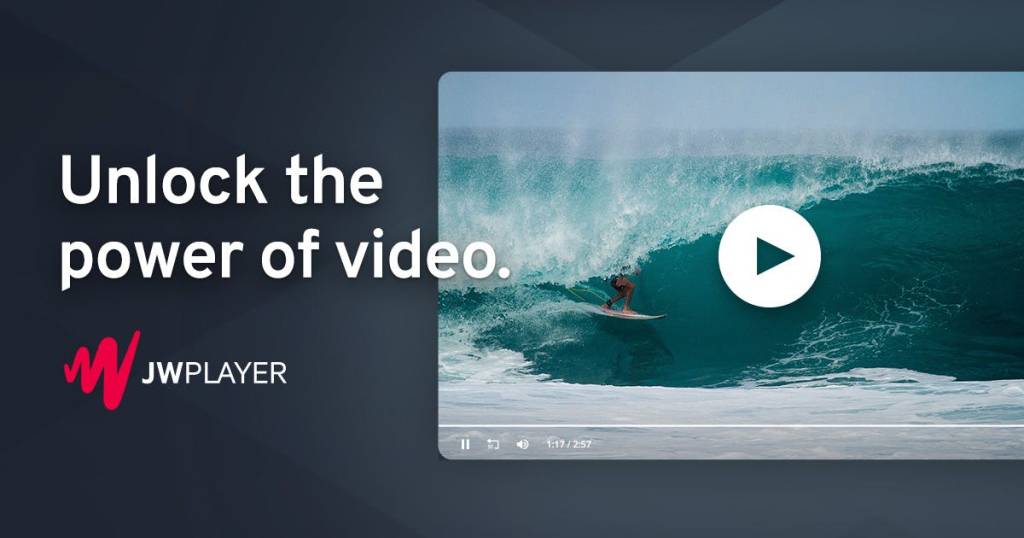

JW Player has pricing plans that are comparable to the top enterprise video solutions.
Overview and Company History:
JW Player is a secure live streaming platform that offers VOD hosting and live streaming at affordable prices. This company was originally known for its video player, that shared some of its code with the initial YouTube video player. This enterprise video platform offers limited features and is best suited for those on a very tight budget who don’t mind its limited capability.
Basic Functionality:
JW Player is a good enterprise video software for those looking for lower prices and great customer service. However, they must be willing to sacrifice access to some features and services.
Key Features:
The JW Player platform offers a full set of video streaming services for enterprise broadcasters.
This enterprise video platform includes an HTML5 video player with support for the latest technologies, such as the MPEG-DASH protocol, multi-bitrate streaming, simulcasting to Facebook Live, DRM security, and more.
Detailed Features:
- Global content delivery, except for China
- Video API available with all plans
- Monetization via advertising
- Multi-bitrate and adaptive streaming
- Tech support but limited to email support for cheaper plans
- Enterprise-grade secure video streaming delivery
Pros:
- High-quality video player
- Simple, easy-to-use video platform
- Advertising capabilities
Cons:
- Live streaming limited to 6 hours
- Only supports AVOD
- Limited tech support
- No China video delivery
Best Use Cases:
- Streaming video for sales
- Marketing video hosting
- Enterprise video hosting
Technical Specifications:
- Recommended dimensions: 360p to 1080p (480×360 to 1920 ×1080)
- Supported aspect ratios: 16:9, 4:3, 2.39:1
- Maximum file size: 25 GB
- Maximum video length: Unknown
- Total file storage: 25 GB to 500 GB, depending on the plan
- Accepted video formats: MP4, WMV, AVI, MOV, 3GP, FLV
Pricing:
JW Player has custom pricing plans. You can get in touch with their team to find out the pricing details. However, you can get a 30-day free trial to get a feel of this enterprise video platform’s capabilities first.
JW Player is a long-term player in the enterprise video streaming solution market that offers an affordable starter plan and customizable enterprise plans for organizations with larger video hosting needs.
9. StreamShark


StreamShark’s OTT platform features a live streaming workflow with easy-to-use features and global CDN delivery. Source: StreamShark.io
Overview and Company History:
StreamShark is one of the best enterprise video platforms providing multi-faceted online video functionality. In fact, StreamShark is a business wing of MetaCDN. This means that the platform specializes in fast and innovative content delivery.
Basic Functionality:
As a streaming service with an enterprise pricing solution, this company offers both a consumer-grade (B2C) platform and a distinct enterprise platform for streaming. StreamShark is a technology company with expertise in reliable video stream delivery for global reach. This enterprise video platform excels at making the live streams of large-scale, high-profile events a massive success, with viewers having an exceptional viewing experience.
Key Features:
Their live event platform offers users the ability to efficiently and reliably manage the different phases of an event’s stream while ensuring maximum reach and reliability of the live stream via its multi-vendor approach and HLS ingests. Additionally, the company focuses on providing global video CDN services overall.
Detailed Features:
- SSO support
- Global coverage via a multi-CDN network
- Mobile compatibility
- Detailed viewer reports
- Customizable live streaming video player
- Privacy controls
- Advertising and customer support
Pros:
- Localized media ingestion
- Encoding support
- Video redistribution
- Large storage capacity
Cons:
- Does not offer channels for video organization
- No embeddable playlists
- Minimal analytics
- Does not support China video delivery
Best Use Cases:
- Enterprise video hosting
- Large-scale streaming
- High-profile event streaming
Technical Specifications:
- Recommended dimensions: 240p is the recommended minimum to 1080p or 4K (depends on the user’s hardware and internet)
- Video aspect ratio: No restrictions (but 16:9 is the default)
- Max file size: None
- Max video length: None
- Total file storage: 10-1000GB (depends on plan)
- Compatible video formats: MP4 (preferred), MOV, M4V, M2V, AVI, MPG, FLV, WMV, MKV, WEBM, OGV, MXF, ASF, VOB, MTS
Pricing:
Monthly live streaming plans with StreamShark begin at $199 per month and include the following:
- Standard: $199/month; includes 1,000 GB of bandwidth; overage charges of $0.10/GB
- Team: $499/month; includes 4,000 GB of bandwidth; overage charges of $0.09/GB
- Business: $999/month; includes 9,000 GB of bandwidth; overage charges of $0.08/GB
- Enterprise: Please contact StreamShark for their custom enterprise solutions and plans
StreamShark is an enterprise video solution platform that specifically works with larger broadcasters and organizations.
10. Dacast
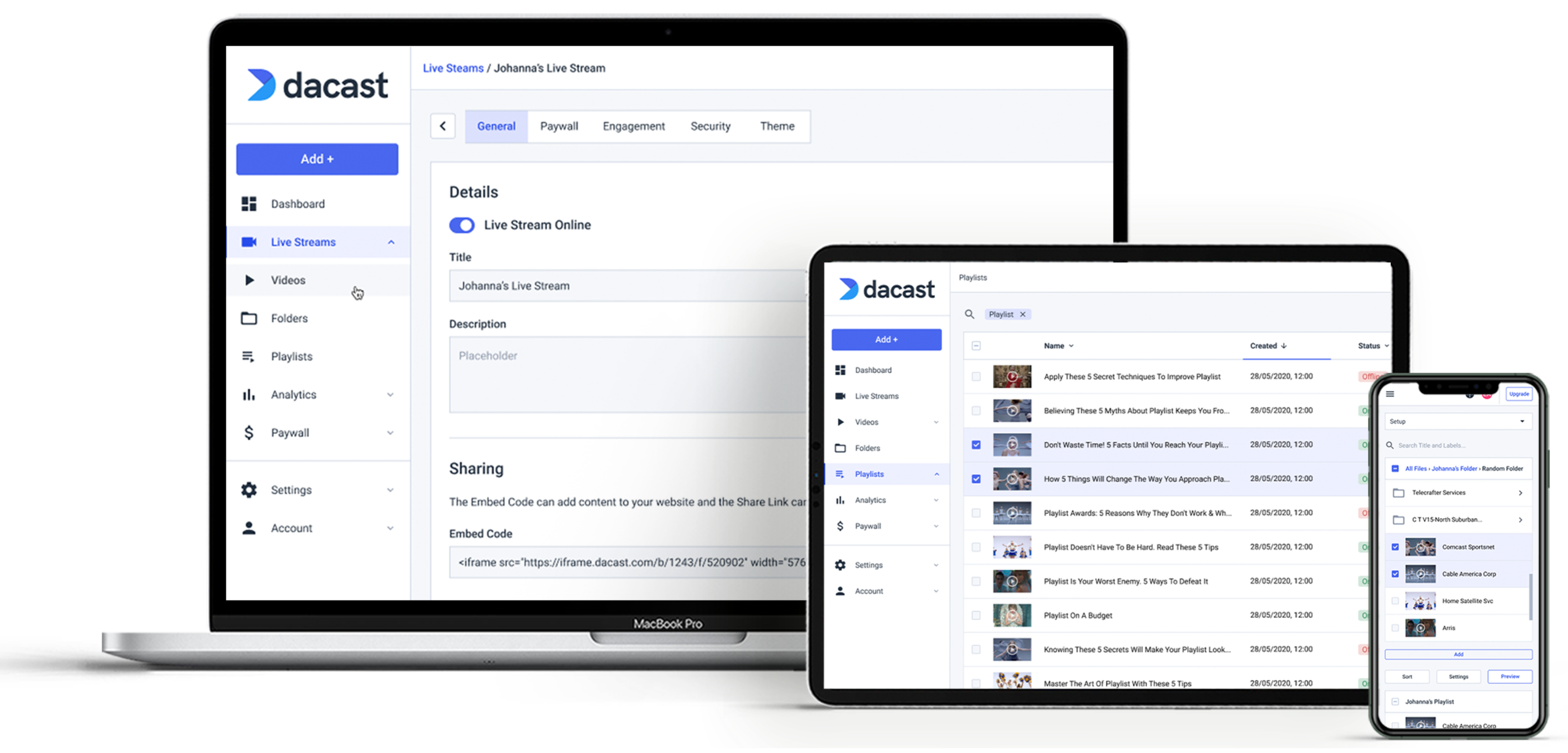
Overview and Company History:
Dacast is a full-featured, self-service enterprise video platform for both live streaming and VOD hosting, that offers all the features of professional enterprise-grade software at competitive prices. It is an enterprise video platform designed for business professionals and enterprise users. Hence, the video is delivered via a top-tier CDN.
All levels of experience can use Dacast, but it may take some time to fully understand all the features available.
Dacast is a unified enterprise video platform that made the annual list of the most important, innovative, and interesting companies for 2021 Streaming Media Magazine’s Top 50 List. This powerful enterprise video platform helps companies around the world scale and monetize their online video content.
Basic Functionality:
Dacast provides comprehensive live streaming and online video hosting services. Users can embed videos on their own websites while maintaining 100% control of their content. Among other features, Dacast is an enterprise video platform that offers an integrated paywall, password protection, referrer restriction, and a video analytics dashboard.
Key Features:
Dacast distinguishes itself from other enterprise video platforms by offering high-end features with competitive pricing plans. These include ad-free broadcasting, white-label service on all plans, and top-tier CDN delivery. 24/7 phone support is also available for Premium and Enterprise plans.
Additionally, the Dacast enterprise video platform stands out from other OVPs with its ease of use and accessibility. Even new broadcasters can create a new live channel and start a new live stream in just a few minutes.
Detailed Features:
- Secure, global content delivery, including industry-best video hosting
- Zoom live streaming integration
- 24/7 tech support with all plans, including email and live chat
- Video security features, including password protection and encryption
- RTMP Encoder for ingesting HLS streaming
- Player API access for 3rd party player integration
- Video API access on premium plans (scale and event)
- Adaptive multi-bitrate streaming
- Cloud-based video transcoding
- Expo galleries video portal
- Real-time analytics
- Ad-free HD streaming
Pros:
- Live streaming and VOD streaming packages on all pricing plans
- Unlimited concurrent viewers
- Unlimited live channels
- White label and branding control
- Embeddable HTML5 video player
- SVOD, AVOD, and TVOD monetization options
- Mobile device support
- Live stream recording
- China Video Hosting
- Plans for every budget
- Enterprise-grade secure delivery
Cons:
- Requires a bit of a learning curve
Best Use Cases:
Dacast is suited for:
- Live event streaming
- Video on demand hosting
- Streaming video for education
- Enterprise video platform
- Marketing video Hosting
Technical Specifications:
- Recommended dimensions: 240p is the recommended minimum to 1080p or 4K (depends on the user’s hardware and internet)
- Video aspect ratio: No restrictions (but 16:9 is the default)
- Max file size: None
- Max video length: None
- Total file storage: 10-1000GB (depends on plan)
- Compatible video formats: MP4 (preferred), MOV, M4V, M2V, AVI, MPG, FLV, WMV, MKV, WEBM, OGV, MXF, ASF, VOB, MTS
Pricing:
Dacast’s pricing plans come in 4 different packages suitable and customizable to any organizations needs:
- Starter – $39month, billed annually for 1,000 GB of bandwidth and 50 GB of storage monthly
- Event – $63/month, billed annually for 6 TB of bandwidth upfront and 50 GB of storage upfront
- Scale – $165/month, billed annually for 24 TB of bandwidth per year and 1 TB of storage
- Custom – Please contact us for custom pricing information.
For more details, you can check out this third-party review of several streaming platforms, including Dacast.
Dacast is a strong enterprise video streaming solution with packages for both large and small enterprises. They have the tools to support your enterprise’s streaming needs.
11. Muvi
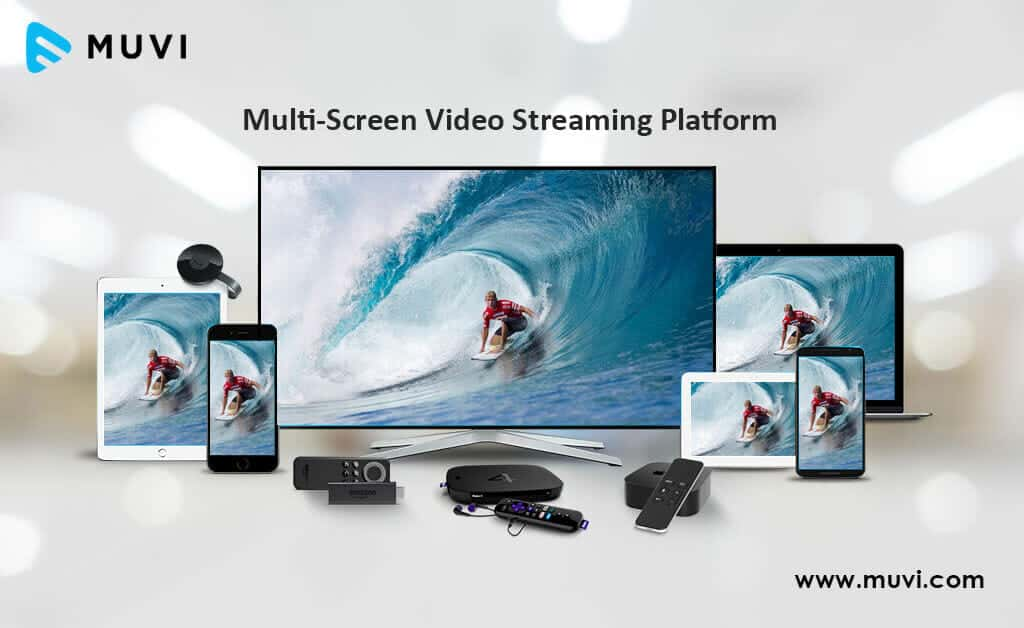

Muvi is an OTT solution designed for broadcasters with a lot of experience.
Overview and Company History:
Muvi is another great enterprise video platform. This platform is especially well-suited for OTT video hosting.
Their unique model empowers users to launch their own video or audio streaming platform quickly and easily. The enterprise video platform includes an all-inclusive and fully-featured website, and mobile and TV apps.
Basic Functionality:
Muvi is an enterprise video platform that supports both live and on-demand video content. Their service allows businesses to launch white-label multi-device video streaming services for both audio and video. It includes fully managed, end-to-end solutions, all controlled from one unified platform.
Although this provider carries out highly technical functions, it is so well-built that no coding or IT team is required.
Key Features:
With Muvi, you can create a multi-screen OTT VOD platform relatively quickly. Their video streaming solution comes with a plethora of functionalities and capabilities.
Detailed Features:
- Customizable video player
- HTML5 video player
- Powerful video analytics
- Video monetization tools
- Secure streaming
- White list, Black list and other Geo block functionalities
- Biometric authentication
Pros:
- White-label with branding customization
- HTML5 video player
- Video analytics
- Monetization tools
- DRM and security features
- Live and on-demand hosting
- Powerful built-in CDN
- Video CMS
- Transcoding
- Secure streaming
- Website and Apps for Mobile and TV
Cons:
- Hard to integrate or connect external app
- CMS user interface is complex
- No China video delivery
Best Use Cases:
- Advanced video hosting
Technical Specifications:
- Recommended dimensions: 144p (256 x 144) to 4k (3840 x 2160)
- Aspect ratio: 16:9, 4:3
- Max file size: not available
- Max video length: not available
- Total file storage: 1TB, 2TB, 5TB (depending on plan)
- Compatible video formats: MP4, MOV, MKV, FLV, VOB, M4V, AVI, 3GP, MPG
Pricing:
Muvi offers video hosting and streaming services under five categories including, Muvi One, Live, Flex, PlayerSDK, Playout, and Alie. The most popular plan is the Muvi One plan.
Muvi One has five different pricing plans:
- Standard: $399/month (+ $299/month per app + infra fees), allows 2000 concurrent viewers, 1TB of bandwidth, 1 TB of storage, and API access.
- Professional: $1,499 per month (+ $499/month per app + infra fees) increases limits and adds premium support.
- Enterprise: $3,900 per month (+ $499/month per app + infra fees) adds a dedicated server with auto-scaling.
- Ultimate: Custom pricing. This plan includes everything in the Enterprise plan along with unlimited concurrent users, monthly security and performance reports, and more.
Muvi also offers add-on features like e-learning, content partner portal, advanced live chat plugin, and UGC at additional costs. It also offered a free trial period for all its plans. For more information, check out this third-party review of this enterprise video platform.
If you are looking for an enterprise video platform that will allow you to launch your own OTT platform, Muvi is a great choice.
12. TwentyThree


TwentyThree is a European video hosting platform for business.
Overview and Company History:
TwentyThree is an enterprise video platform with both personal and enterprise streaming services. This powerful solution is geared towards marketing, and it offers scalable support for growing businesses.
Basic Functionality:
The streaming plans from TwentyThree are on the pricier side, so they are best suited for businesses with a hefty budget.
Key Features:
TwentyThree enterprise video platform provides all the tools for enterprise businesses around the world to succeed with video. Marketers can leverage their video marketing features including single sign-on, unlimited video storage and traffic, advanced security, multiple backends, and governance filters.
Detailed Features:
- Enterprise video hosting
- Webinar hosting
- Video marketing tools
- Team management
- Data tracking and analytics
- Full GDPR compliance
- SSL/TLS hosting
Pros:
- Large collection of enterprise-grade streaming tools
- Scalable streaming plans
- Reliable customer support
- Long time player in the streaming space
- Secure content delivery online
Cons:
- Some issues with integrations
- Issues with chat feature
- Requires a bit of a learning curve
Best Use Cases:
- Enterprise video hosting
- Personal video hosting
Technical Specifications:
- Recommended dimensions: 1920 x 1080 px or larger
- Video aspect ratio: 16:9
- Max file size: Unavailable
- Max video length: Unavailable
- Total file storage: Unlimited
- Compatible video formats: .MP4, .AVI, .WMV, .MOV, and more
Pricing:
TwentyThree splits its pricing plans into three main categories: Personal, Video Marketing Platform, and Webinars. There are several plans under each of these categories. Here’s how they are broken down:
Personal:
- Pro: £19/month (~ $20.69/month/user)
- Enterprise: £39/month (~$42.46/month/user – minimum of 50 users)
Video Marketing Platform:
- Video Marketing Platform: €499/month (~$543/month)
- Complete Video Marketing Platform with Webinars: €2499/month (~$2722/month)
- Enterprise: Custom-priced for advanced streaming needs
Webinar: h)
- Pro: €499/month (~$543/month)
- Complete: €1499/month (~$1632/month)
- Enterprise: €2499/month per workspace (~$2720/month)
TwentyThree has strong enterprise video marketing and webinar plans for larger companies.
FAQ
1. What is the most popular video platform?
The most popular video platform in the world is YouTube, which is also free to use. However, if you’re considering an enterprise video platform, here are the best ones in the market:
- Dacast
- Brightcove
- IBM Cloud Video
- Vimeo Livestream
- Hippo Video
- Kaltura
- Cincopa
- JW Player
2. What is an example of a video platform?
A video platform is essentially a solution that enables you to host your video content and get it across to your audience. The best example of a video platform is YouTube—the biggest one in the world. It enables users to easily upload videos and share them with billions of YouTube users.
3. What video platform is free?
The best free video platforms for enterprises include:
- IBM Cloud Video
- Vidyard
- Hippo Video
- JWPlayer
4. Is there another video platform like YouTube?
Yes, there are numerous other video platforms like YouTube that enable you to upload your videos for free. Your audience can also access them without any costs. These platforms include Dailymotion, Facebook, Instagram, TikTok, Vevo, Vimeo, and more.
5. What is the most secure way to send a video?
For secure video delivery, it’s essential to choose a consumer or enterprise video platform that offers superior privacy and security features. Look for tools that offer viewing controls and limited distribution options. It can help ensure that only those who have access to your video can watch it.
6. What is an enterprise video platform?
An enterprise video platform is a digital tool or system that is used to manage and streamline all aspects of video production in large-scale organizations. It’s designed to streamline hosting and manage the overall video management in an organization.
7. What does Brightcove do?
Brightcove is a dynamic enterprise video platform used by media houses and organizations from all over the world. It is provides services like hosting, media scheduling, analytics, and CDN services.
Final Thoughts: Choosing the Right Enterprise Video CMS
Researching and selecting an enterprise video platform can be a daunting task, but it doesn’t have to be with the comparison that we’ve shared with you. With this list of essential features and an overview of the leading enterprise-grade online video platforms, we hope it feels feasible to evaluate and choose the best solution for your needs.
Of course, we do hope you’ll consider streaming with the Dacast enterprise video platform. With Dacast’s video hosting for business services, we guarantee our broadcasters all five of the features outlined above – and more!
With all Dacast pricing plans, broadcasters have access to a top-tier CDN, a secure platform, customizable user access options, video and developer APIs, and ad-free, white-label service. Whichever enterprise video platform you choose, we highly recommend taking advantage of free trials when available.
To start streaming live with Dacast, simply click the button below to sign up for our 14-day free trial (no credit card is required). We’ll have you up and streaming in a matter of minutes!
Finally, for exclusive offers and regular live streaming tips and tricks, you’re invited to join our LinkedIn group. We love to hear from our readers. If you have any https://www.dacast.com/signup/questions or comments, leave them in the comment section below, and we’ll be sure to get back to you.


